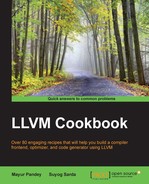This recipe shows you how to define registers and register sets in .td files. The tablegen function will convert this .td file into .inc files, which will be the #include declarative in our .cpp files and refer to registers.
We have defined our toy target machine to have four registers (r0-r3), a stack register (sp), and a link register (lr). These can be specified in the TOYRegisterInfo.td file. The tablegen function provides the Register class, which can be extended to specify the registers.
To define the backend architecture using target descriptor files, proceed with the following steps.
- Create a new folder in
lib/TargetnamedTOY:$ mkdir llvm_root_directory/lib/Target/TOY - Create a new
TOYRegisterInfo.td filein the newTOYfolder:$ cd llvm_root_directory/lib/Target/TOY $ vi TOYRegisterInfo.td
- Define the hardware encoding, namespace, registers, and the register class:
class TOYReg<bits<16> Enc, string n> : Register<n> { let HWEncoding = Enc; let Namespace = "TOY"; } foreach i = 0-3 in { def R#i : R<i, "r"#i >; } def SP : TOYReg<13, "sp">; def LR : TOYReg<14, "lr">; def GRRegs : RegisterClass<"TOY", [i32], 32, (add R0, R1, R2, R3, SP)>;
..................Content has been hidden....................
You can't read the all page of ebook, please click here login for view all page.
